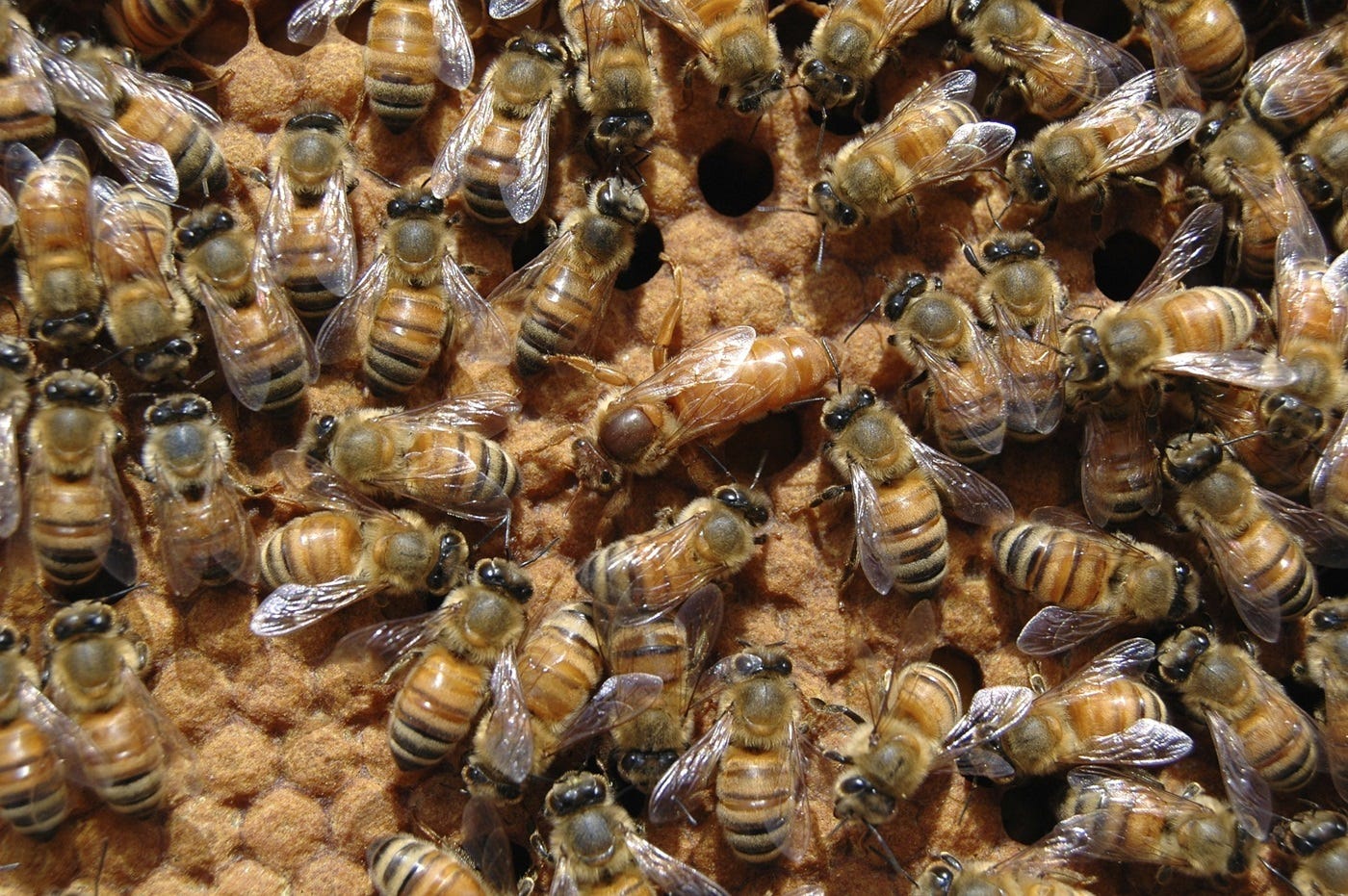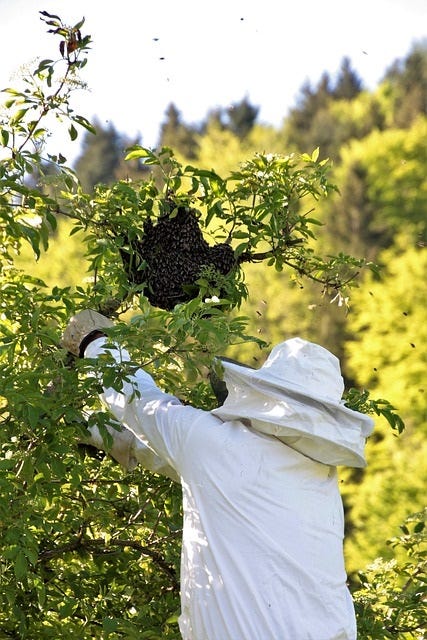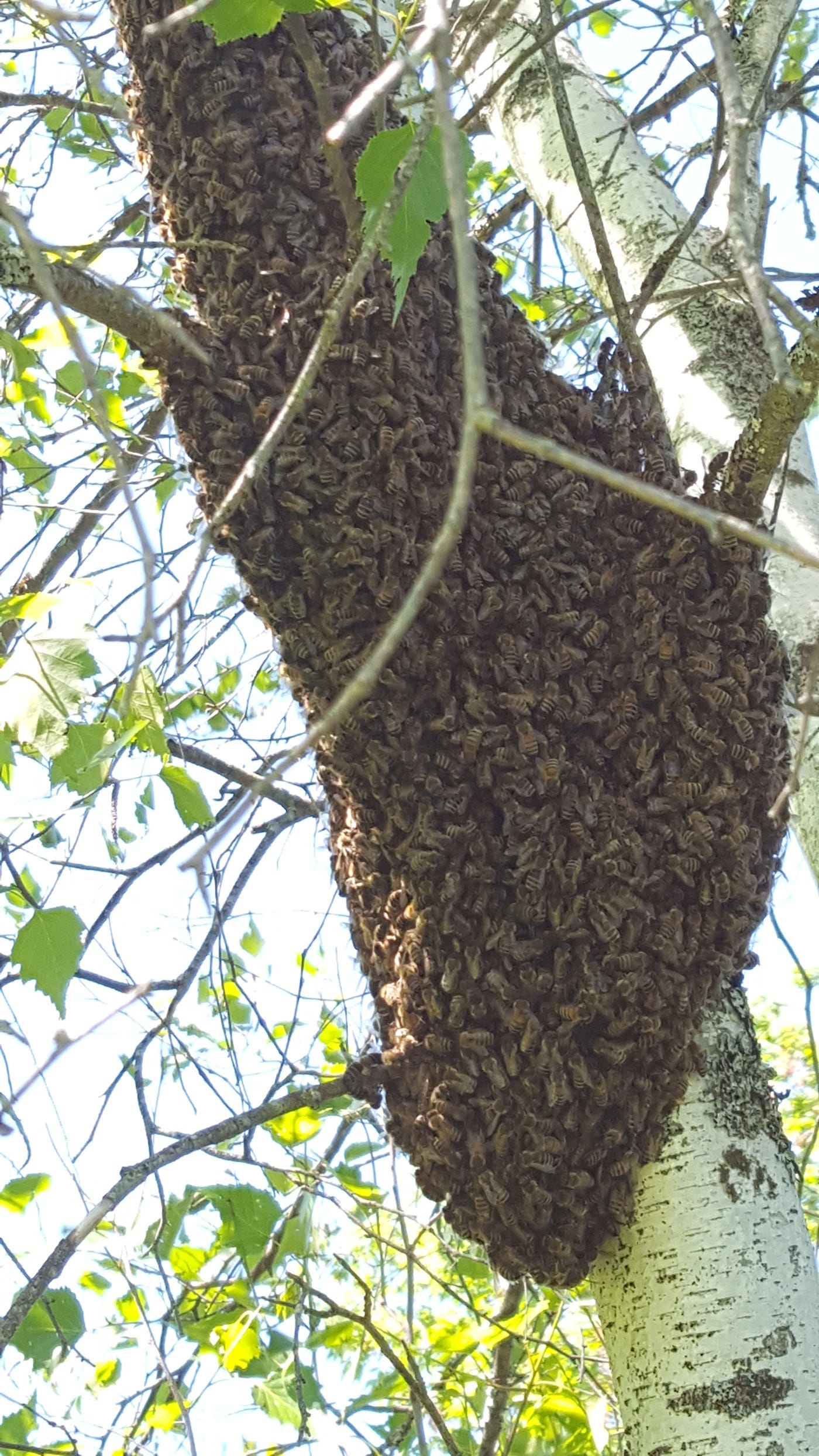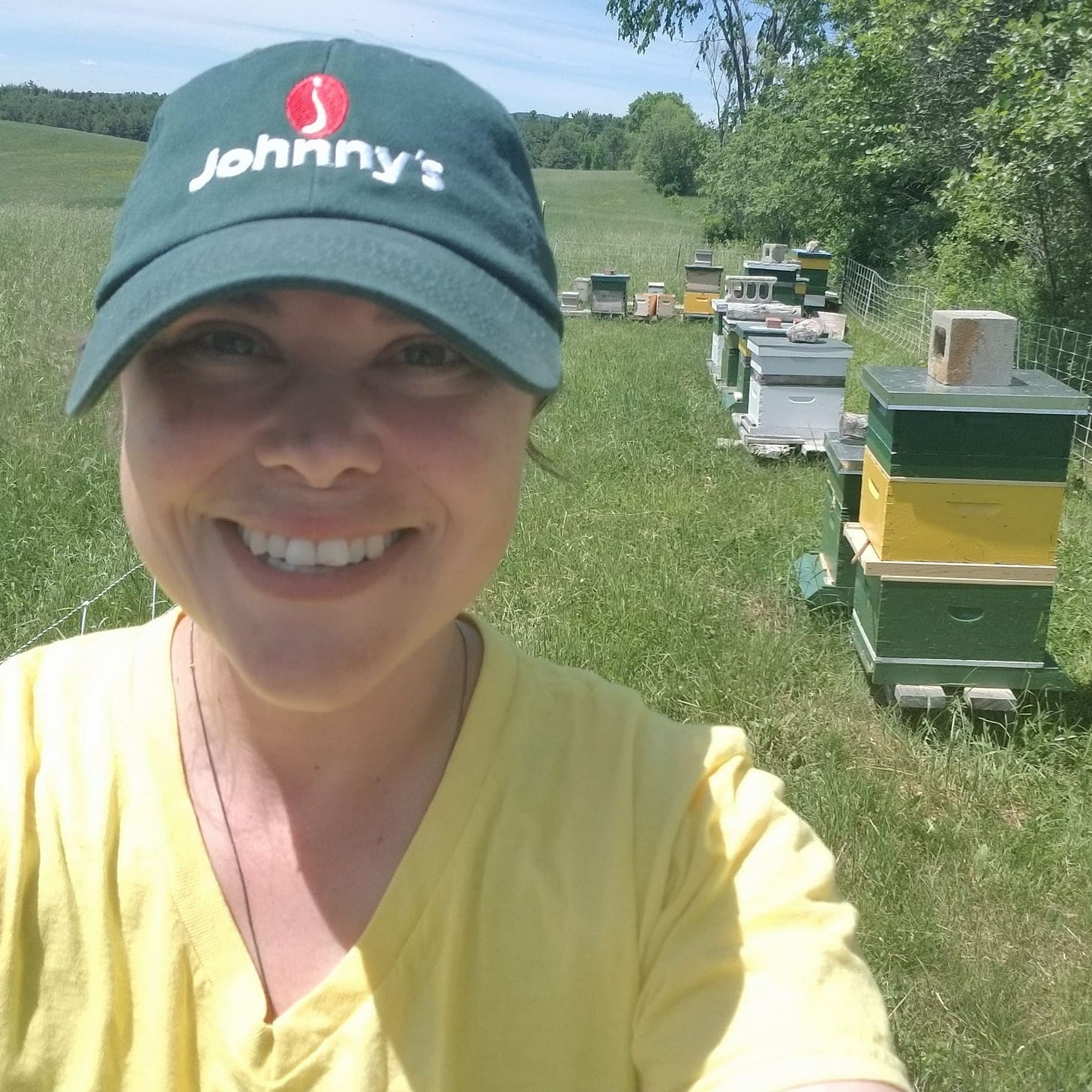The Universe Sent Me Bees
In all my years keeping bees, I’ve never had a swarm just move themselves in...
“What’s that noise?” Carolyn asked as we stood on the porch chatting. It was a sultry Sunday evening and my life-long bestie had stopped by to drop some things off.
Looking out the front door, I saw the unmistakable cloud of bees swarming in fron t of the barn and giddiness flooded through me. “It’s a swarm of bees!”
Heedless of the thousands of bees flying every which way, I stepped outside to view the spectacle. A honeybee swarm is a magnificent feat of nature, and this one was moving itself into the abandoned hive equipment stored in the barn. Get yourself a cuppa, and join me at Runamuk Acres for the latest farm-update.
Welcome to the latest Updates From the Farm! If you are new here, I invite you to check out my About page to learn what this is, who I am and why I am doing this. Or just dive right in! At “Runamuk Acres” you’ll find the recantings of one lady-farmer and tree-hugging activist from the western mountains of Maine. #foodieswanted
Coming into 2024, I’d committed to not making any new farm-investments in order to stabilize Runamuk’s finances after a rough couple of seasons. Even after my last remaining colony perished during the winter, I held fast to that goal and made no move to replace them. For the first time in 15 years, I was a beekeeper without bees.
Honeybee Democracy
It’s commonly mistaken that the Queen runs the show in a beehive, when—in fact—she is but a slave to her subjects. A honeybee hive is run by it’s population of workers. The ultimate democracy.
It is the workers who dictate when their Queen will eat, sleep, and lay eggs—up to 2,000 a day at the height of the season. Thus, it is not the Queen’s decision if and when to swarm, but that of the worker-bees. When the colony becomes too populous and life inside the hive is crowded and congested, leaving little to no room for stores of pollen and honey, the workers will get the urge to swarm.
I was working in the barn last Sunday afternoon and noticed some interest in the equipment I’ve stored in the back corner. I knew they were either harvesting whatever remaining resources might still be in those combs, or they were looking at it as a potential hive-site.
If you’ve been following Runamuk’s story for any length of time, you may recall that I built my business on bees. Beekeeping allowed me to grow my income from agriculture even as a landless farmer, and I had upwards of 30 hives when I finally bought my own farm. I was raising Queens and selling nucleus colonies locally, selling raw honey, and making beeswax products like soap and herbal salves.
Buying the farm brought about an unintended shift in priorities, and I’ve since scaled back my beekeeping operation to better meet the needs of the farm as a whole. Yet, even still, that affinity and fascination with honeybees lingers for me, and I know I am not ready to give them up entirely.
We each worked in harmony. Me—painting this infernal piece of lattice I’ve been working on in my downtime, nursing a cocktail and listening to tunes, having myself a right old barn party on a quiet Sunday afternoon. The bees—buzzing past my head and about my body on their way in and out of the open barn door.
It was a little late in the day for foragers to be working, I knew. Generally, bees forage during the hottest part of the day. By 4pm they’re winding down and making their way home for the night.
The steadily increasing flow of bees indicated to me that these were swarm-scouts and I became hopeful. In all the years I have been keeping bees, I’ve never had a swarm just move themselves in. I’ve heard of it happening to other beekeepers or to those who inherit old equipment with their barn or outbuilding, but never had it happened to me.
When I think about all the trouble I’ve gone to in the past to collect honeybee swarms, it makes me chuckle.
One time, I trucked 30-minutes or more to some obscure location to pick them off the underside of a lawn-chair. That was probably the easiest swarm I ever collected.
In another instance, I stood on top of the cab of my truck in full-beekeeper apparel, in the middle of a hay field—with cars passing by—as I inched a 5-gallon pail on an 8-foot stick up under the branch of a massive pine. The plan was to hit the underside of the branch with the pail to knock the swarm into the bucket, but instead I ended up with a swarm of bees on my head!
More recently, I cut into the wall of a house in hopes of retaining the Queen with enough brood and bees to establish the colony back at the farm. Check out this post: Bee Call to read that story.
Swarming 101
It takes a bit of preparation for the colony to be able to swarm. They’ll build “Queen-cells” and supercedure cells throughout the hive, raising multiple new Queens over the course of 21 days. Meanwhile, to help the existing Queen lose weight in preparation for flying, the workers run her round and round the hive.

Quite often, swarming occurs following a period of rainy days, when the bees have been confined to the hive due to weather. Once the sun returns, the colony comes to the consensus that the time has come.
Half the colony will abscond from the hive, taking the old Queen with them. Left behind with the new Queen are the entirety of the colony’s brood: all of the eggs and larvae in various stages of development, the colony’s nurse bees who are yet unable to fly, any drones (male bees), and any foragers in the field who missed the memo on swarming.
Emerging from the hive in a cloud of zig-zagging bees, the swarm initially settles nearby to the parent hive. Alighting on a branch or some other creative location, the workers ball around their Queen to keep her safe from predators. Insect-eating birds will happily pick off a fat, juicy Queen-bee.

Sitting there, the colony sends out scouts to search for a new home. Each scout, after locating a potential hive-site, returns to the colony to petition others (in dance, of course) to come check out what they’ve found. The scout leads more and more bees to her site until the majority agree that hers is the place to be.
I’ve missed bees!
I didn’t realize how much I’ve missed working with bees until recently. When I opened the cover of the bee-boxes I’m using to protect the outlet and fence-charger on the field, the smell of beeswax, honey and propolis wafted over me. Heated by the hot summer sun, the wooden boxes emanated the intoxicating fragrance and I inhaled deeply, absorbing that beautiful scent into the very depths of my soul.
I’d retreated into the house for the night, content to let nature take it’s course. If a swarm moved into the barn I’d know in the morning. By the time Carolyn stopped over later that evening, I’d forgotten all about it.
What a joy to catch them moving in! To stand there, bees flying all around us as we watched the spectacle.
Bees are very linear thinkers and had only one thought in mind: to get their Queen to safety and move the colony into it’s new home. They cared not one whit that we were standing in their midst.
The Universe Sent Me Bees
I’ve been too fortunate in my life to mistake the power of manifestation and the blessings that have come to me as a result. The moment I made up my mind that my story was not what others dictated, setting out to create the life I truly wanted to live—that was the moment everything changed for me.
The Universe brought bees into my life 15 years ago with the gift of a hive set-up from a family friend. That gift spurred me to bring home my first colony of honeybees, and I was promptly consumed by “bee-fever”. So much so, that I was inspired to establish a local beekeepers’ club for the Kennebec Valley region where I live. For 6 years I served as President of the Somerset Beekeepers, teaching bee-schools and giving beekeeping presentations within the community. That 1 hive led me to beekeeping as a means of growing my business even as a landless farmer, eventually allowing me to buy my own farm.
Don’t get me wrong, it’s been a long and tumultuous journey of intense physical labor, an emotional roller coaster to be sure, but how can I see this swarm as anything other than a gift from the Universe? A sign that I’m on the right path, doing what I’m meant to be doing.
The Universe sees me. It sees my efforts, my love for nature—the sacrifices I am willing to make—and it said, “No, Sam. I know what you are trying to do and why you did not buy new bees this year, but you will have bees. You’re a beekeeper just as much as you are farmer, writer and mother—and don’t you forget it!”
And the Universe sent me bees.
Much love to you and yours, my friends!
Your friendly neighborhood farmer,
Sam
Thank you for following along with the story of this lady-farmer! It is truly a privilege to live this life serving my family and community, and protecting wildlife through agricultural conservation. Check back soon for more updates from the farm, and be sure to follow @RunamukAcres on Instagram or Facebook!








How wonderful to sit and enjoy your story this morning on my day off. Several years ago I had a swarm cover the front of my bedroom window. I have to admit I was terrified at the time. I've since learned so much more about how and why bee's swarm. And thanks to you I've learned to love and appreciate them so much more. Enjoy your wonderful bee's. What a perfect gift from the Universe for you.
Glad to see you wearing Johnny seeds hat . My cousins late husband was operation manger for many years. Best seeds to grow, tested to provide strong results.